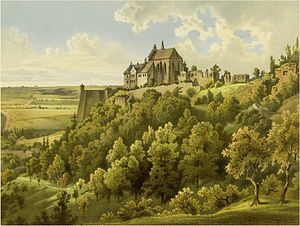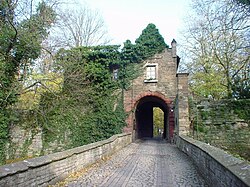Mansfeld Castle
| Mansfeld Castle | ||
|---|---|---|
|
Aerial view of Mansfeld Castle 2017 |
||
| Alternative name (s): | Mansfeld Castle | |
| Creation time : | 11th century | |
| Castle type : | Hilltop castle | |
| Conservation status: | Rebuilt. | |
| Standing position : | Count castle | |
| Place: | Mansfeld | |
| Geographical location | 51 ° 35 '37.7 " N , 11 ° 27' 28.5" E | |
|
|
||

, Mansfeld Castle and Castle Mansfeld called, is a castle in Mansfeld in Mansfeld-Südharz in Saxony-Anhalt .
location
The castle hill bears the ruins of an important fortress as well as the ruins of three castles of the Mansfeld counts and the completely preserved castle church.
history
Long before it was first mentioned in a document in 1229, there was a Romanesque fortification as the seat of the old Mansfeld family of counts. The name Mansfeld was first mentioned in 973. Excavations have found the rest of the keep and a wall in opus spicatum construction method that can be placed in the second half of the 11th century. 1060 a Count Hoyer von Mansfeld is known as the landowner. In 1229 the old family of counts with Burchard I died out and the castle fell into disrepair after his daughters Gertrud and Sophie had divided the county; one was married to a burgrave of Neuchâtel , the other to a burgrave of Querfurt . The son of the second, Count Burchard V. von Querfurt, also became Count von Mansfeld in 1260 and took his seat at the castle in 1264. Major repairs are likely at this time. He founds the Counts of Mansfeld second tribe, who are also lords of Schraplau from 1267 to 1412 .
Extensive expansion measures were carried out in the 14th century so that the castle withstood the sieges of the Bishop of Halberstadt in 1342 and the Margrave of Meißen in 1362. In 1501 there was an inheritance division of the Mansfeld counts. The counts began the construction of three representative castles on the castle hill, which subsequently served to designate the genealogical lines: Vorder-, Mittel- and Hinterort . The most important artists of the Central German Early Renaissance were brought in to help build the castles . In terms of art history, the castles stood in a row with the Albrechtsburg in Meißen , the Merseburg Castle and the Bernburg Castle .
In the course of the palace construction, a strong joint fortification was built from 1517 to 1549. These fortifications corresponded to the modern, early modern fortification theory of the time. Among other things, the Nuremberg fortress builder and gun founder Matern Harder was involved in the construction. The principle of the “bastion castle”, ie that the fortification system was arranged independently of the castle buildings, was followed here. The fortress was continuously expanded and strengthened, so that in the 16./17. Century was one of the strongest fortresses in Germany.
Not least because of the construction and maintenance work on the two fortresses of Mansfeld and Heldrungen (which had been acquired by the Hinterort line in 1479), the power and fortunes of the Mansfeld counts declined, so that the county was sequestrated in 1579 . Electoral Saxony and the ore monastery of Magdeburg shared ownership. In the second half of the 16th century, the fortress passed to the Archbishopric of Magdeburg. Until the fortress was razed 100 years later, the fortress was a plaything in the power striving of the Prussian and Saxon princes. Electoral Saxony advocated the demolition of the fortress, while they wanted to expand the archbishopric, which was partly administered by Kurbrandenburg, as an outpost to the strongest fortress on the Elbe, Magdeburg. During the Thirty Years War the facility was besieged several times, but never taken by storm. In 1650 the fortress was handed over to the Count of Mansfeld-Hinterort. At that time it only had a crew of twelve and was in poor structural condition.
In 1664 the Magdeburg administrator occupied the fortification and had it repaired. He squeezed the necessary financial resources from the Mansfeld estates. Since the cities and estates could no longer bear the funds for the occupation and maintenance of the fortress, they demanded that the fortress be abandoned in 1665. In 1672 the district council of Leipzig decided to demolish it . The fortifications were then destroyed in 1674/75, so that only ruins remain today. The castles fell into disrepair at the end of the 16th century. Vorderort Castle alone was maintained and inhabited.
In the years 1859 to 1861, Baron Carl Adolph von der Recke rebuilt the early renaissance castle Vorderort in a neo-Gothic style after he had acquired the Schlossberg from the Prussian state. The Hamburg builder Maximilian Wallenstein was in charge of the construction; some of the plans came from Friedrich August Ritter. Recke and later his son Ado held the office of district administrator of the Mansfeld mountain district until 1906. The latter died in the castle in 1927. The von der Recke family fled in 1945 and were expropriated by the land reform in the Soviet occupation zone in 1945 .
Recent history
- 1946: After the land reform, the castle fell to the state of Saxony-Anhalt
- 1947: The castle was handed over to the Evangelical Church as a "Luther traditional site" by the state free of charge for use by the Evangelical Jungmännerwerk (today the Christian Association of Young People - YMCA)
- 1953: As part of the political agitation against the “Illegal Organization Junge Gemeinde ”, the castle was expropriated and handed over to the Free German Youth (FDJ). After the " new course " of the government of the GDR (June 11, 1953) it was returned to the Evangelical Church, and the Jungmännerwerk manages the castle on behalf of the church.
- 1997: On May 24th, the Förderverein Schloss Mansfeld e. V. founded to preserve Mansfeld Castle.
- 1999: Transfer of the castle to the property of the Förderverein Schloss Mansfeld e. V. There was a continuous expansion into a modern Christian youth education and meeting place.
sightseeing
Visiting the castle park with the fortifications is possible every day. Guided tours of the outside area of the castle and the castle church take place after registration. In addition, the castle church is also open during the opening hours of the “Wächterstube” castle café. There is a Christian youth education center in the castle. The interior can be viewed in the afternoons of the Open Monument Day (2nd Sunday in September).
Remarks
- ↑ Mansfeld Castle in Mansfeld-Lutherstadt on https://www.lutherstaedte-eisleben-mansfeld.de , accessed on July 22, 2020; Further information on this is also available by telephone: Mansfeld Castle, Tel. 034782/20201
See also
literature
- K. Krumhaar: Attempt a history of the castle and town of Mansfeld . Mansfeld 1869 ( digitized version )
- Ulf Petzschmann: Medieval predecessor buildings and more recent findings at Mansfeld Castle . In: Castles and palaces in Saxony-Anhalt . Issue 10. Hall 2001
- Irene Roch: Mansfeld Castle . E. A. Seemann Leipzig 1972
- Irene Roch-Lemmer: The equipment of the fortress Mansfeld in the 16th and 17th century. In: Castles and palaces in Saxony-Anhalt . Issue 6. Hall 1997
- Irene Roch-Lemmer: The razing of the Mansfeld fortress in the years 1674/75 . In: Castles and palaces in Saxony-Anhalt . Issue 11. Hall 2002
Web links
- Mansfeld Castle
- Friends of Mansfeld Castle
- Mansfeld - A brief history of the castle, fortress, castle church and neo-Gothic castle
- Mansfeld - rise, fall and demolition of the largest fortress in central Germany
- Reconstruction drawing in the medieval state
- Material on Mansfeld Palace in the Duncker Collection of the Central and State Library Berlin (PDF; 254 kB)









